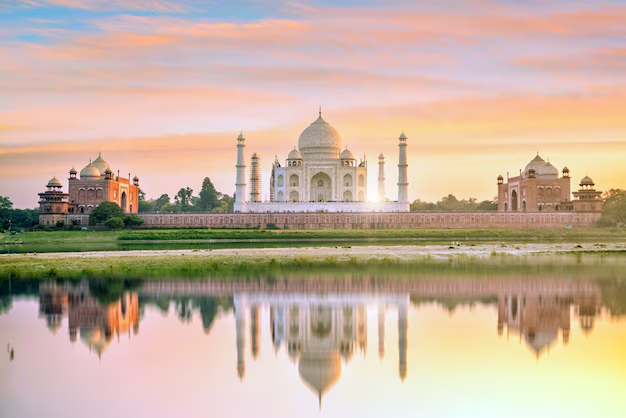Table of Contents
The Taj Mahal is one of the most breathtaking architectural wonders in the world. Located in Agra, India, it is a white marble mausoleum built by Mughal Emperor Shah Jahan in memory of his beloved wife, Mumtaz Mahal. Completed in 1653, the Taj Mahal is considered the most significant symbol of love and a masterpiece of Mughal architecture, combining Persian, Indian, and Islamic styles.Standing on the banks of the Yamuna River, the Taj Mahal is surrounded by lush gardens, reflecting pools, and intricate calligraphy, creating a serene and majestic atmosphere. Recognized as a UNESCO World Heritage Site in 1983, it attracts millions of visitors every year and is regarded as one of the New Seven Wonders of the World.

Origins and Construction
The story of the Taj Mahal begins in the early 17th century with the love between Shah Jahan, the fifth Mughal emperor, and his favorite wife, Mumtaz Mahal. Mumtaz Mahal, originally named Arjumand Banu Begum, was known for her beauty, intelligence, and kindness. She was the emperor’s constant companion and adviser.
Tragic Death of Mumtaz Mahal
In 1631, while giving birth to their 14th child, Mumtaz Mahal tragically passed away. Shah Jahan was heartbroken and went into deep mourning. To honor her memory, he decided to build the most magnificent mausoleum the world had ever seen—a symbol of their eternal love.
Construction of the Taj Mahal
- The construction began in 1632 and took over 20 years to complete.
- Over 20,000 artisans and laborers were involved in the project.
- Materials were brought from all over India and beyond:
- White marble from Makrana, Rajasthan
- Jasper from Punjab
- Jade and crystal from China
- Turquoise from Tibet
- Lapis lazuli from Afghanistan
- Sapphire from Sri Lanka
- Carnelian from Arabia
- 1,000 elephants were used to transport the materials.
By 1653, the grand structure was completed, standing as the finest example of Mughal architecture, blending Persian, Turkish, Indian, and Islamic influences.
Architectural Features
The Taj Mahal is renowned for its symmetrical design, intricate details, and perfect proportions.
1. The Main Mausoleum
- Built entirely of white marble, which changes color depending on the time of day and light conditions.
- It is crowned with a massive onion-shaped dome, rising 73 meters (240 feet) high.
- Four minarets (40 meters each) stand at the corners, slightly tilted outward to prevent collapse onto the tomb in case of an earthquake.
2. The Interiors
- The tomb chamber houses the cenotaphs of Shah Jahan and Mumtaz Mahal, but their actual graves lie beneath, in a lower crypt.
- The walls are adorned with floral designs, inlaid with semi-precious stones, and verses from the Quran in Arabic calligraphy.
3. The Charbagh Gardens
- The Taj Mahal is set within a Persian-style garden, symbolizing paradise.
- It features flowing water, fountains, and lush greenery, creating a peaceful and heavenly ambiance.
4. The Gateway and Mosque
- A grand red sandstone gateway marks the entrance to the Taj Mahal complex.
- To the left of the Taj is a mosque, and to the right is a guesthouse, both made of red sandstone.
Shah Jahan’s Final Days and Death
In 1658, Shah Jahan was overthrown by his own son, Aurangzeb, and imprisoned in Agra Fort. He spent the last eight years of his life gazing at the Taj Mahal from his prison window. In 1666, Shah Jahan passed away, and his body was buried beside Mumtaz Mahal in the Taj Mahal, fulfilling his final wish.
Threats and Preservation
1. Damage Over Time
- During the 18th and 19th centuries, the Taj Mahal suffered from neglect, looting, and British occupation.
- Precious stones were stolen, and parts of the complex were damaged.
2. Environmental Pollution
- Air pollution and acid rain have caused yellowing of the white marble.
- Conservation efforts, including the use of a mud-pack treatment to clean the marble, have helped restore its beauty.
3. Modern-Day Conservation
- In 1983, UNESCO declared the Taj Mahal a World Heritage Site.
- Strict regulations have been implemented to protect the monument from pollution and overcrowding.
The Taj Mahal Today
Today, the Taj Mahal is India’s most famous monument and a global symbol of love and beauty. It welcomes over 7 million visitors annually, including tourists, historians, and architects who admire its elegance and craftsmanship. It remains one of the most photographed landmarks in the world.
On full moon nights, the Taj Mahal glows in silvery light, creating a magical and unforgettable sight. It continues to inspire poets, artists, and lovers across generations.
Conclusion
The Taj Mahal is more than just a mausoleum; it is a testament to love, devotion, and artistic brilliance. Built by Shah Jahan for Mumtaz Mahal, it stands as one of the greatest architectural masterpieces in history. Despite centuries of change, the Taj Mahal remains a timeless wonder, preserving the beauty and romance of the Mughal era.

